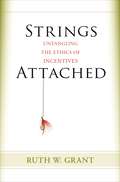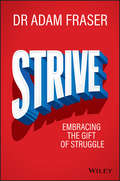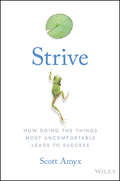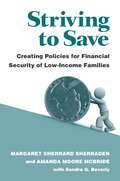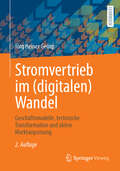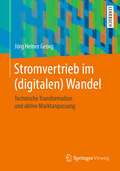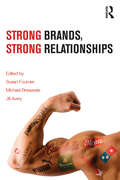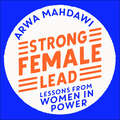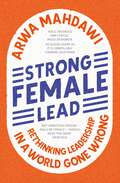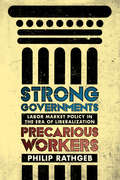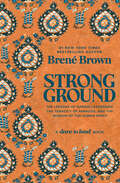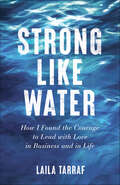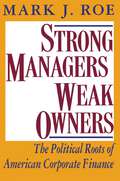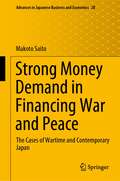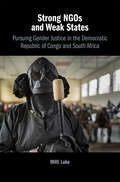- Table View
- List View
Striking a Balance: A Guide to Enhancing the Effectiveness of Non-Governmental Organisations in International Development
by Alan FowlerAt a time of rapid global change, development NGOs are having to scale up their impact, diversify their activities, respond to long-term crises and improve their performance on all fronts. Striking a Balance offers both analysis and a practical guide to how NGDOs can fulfil these demanding expectations. Written for all those involved with NGDO work, the book describes the objectives of sustainablepeople-centred development and the process required to achieve it, focusing on the five factors which determine effectiveness: suitable organisational design; competent leadership and human resources; appropriate external relationships; mobilisation of high quality finance; and the measurement of performance coupled to 'learning for leverage'. In each are the book explains the capacities needed and how they can be assessed and improved. Effectiveness calls for NGDOs which retain their non-profit values, establish the right type of Professionalism, manage dilemmas and balance choices to continually reflect the priorities, rights and needs of those who give them legitimacy: people who are poor and marginalised. This book provides a reference of current and future practices which will help NGDOs to do so.
Strikingly Different Selling: 6 Vital Skills to Stand Out and Sell More
by Jennifer Colosimo Randy Illig Dale Merrill Scott SavageSuperior Sales Success#1 New Release in Global, Direct, and Industrial MarketingYou are competing with the top salespeople in your industry for the same customers. For each sales opportunity there is only one winner.What separates a “winner” from the rest of the very best and makes them “strikingly different”? Six years of focused research involving more than 2,800 sales professionals from 135 countries reveals the 6 vital skills that separate top sales performers from the herd. Learn what it takes to be that one winner!What really works to stand out and sell more? In their book Strikingly Different Selling, Dale Merrill, Scott Savage, Jennifer Colosimo, and Randy Illig (the sales performance experts at FranklinCovey) reveal the secrets to consistent, predictable sales success.The 6 Vital Skills. The author team found that most consultants and sales professionals believed they were doing a great job in their client interactions. Yet 70 percent of the time client executives felt their meetings with sales professionals were a waste of time. To the authors, this was a major surprise. But, for the “Strikingly Different” sales professionals, there were six things they did to consistently outperform their competitors and radically change their client interactions and results.Go from being just one of the sales crowd to the superior choice. Read Strikingly Different Selling: 6 Vital Skills to Stand Out and Sell More and learn the details behind the 6 skills.The 6 vital skills to stand out and sell more:Capture Attention with Verbal BillboardsCreate Excitement with Movie TrailersBuild Confidence with Flashbacks and FlashforwardsBecome Essential with “Why Us!” DifferentiatorsGet Curious and Find the GapsNavigate Traffic Lights and Close the GapsIf you have found books such as SPIN Selling, The Challenger Sale, To Sell is Human, The Secrets of Closing the Sale, or Start with Why to be useful; then your next read should be Strikingly Different Selling.
Strings Attached: Untangling the Ethics of Incentives
by Ruth W. GrantThe legitimate and illegitimate use of incentives in society todayIncentives can be found everywhere—in schools, businesses, factories, and government—influencing people's choices about almost everything, from financial decisions and tobacco use to exercise and child rearing. So long as people have a choice, incentives seem innocuous. But Strings Attached demonstrates that when incentives are viewed as a kind of power rather than as a form of exchange, many ethical questions arise: How do incentives affect character and institutional culture? Can incentives be manipulative or exploitative, even if people are free to refuse them? What are the responsibilities of the powerful in using incentives? Ruth Grant shows that, like all other forms of power, incentives can be subject to abuse, and she identifies their legitimate and illegitimate uses.Grant offers a history of the growth of incentives in early twentieth-century America, identifies standards for judging incentives, and examines incentives in four areas—plea bargaining, recruiting medical research subjects, International Monetary Fund loan conditions, and motivating students. In every case, the analysis of incentives in terms of power yields strikingly different and more complex judgments than an analysis that views incentives as trades, in which the desired behavior is freely exchanged for the incentives offered.Challenging the role and function of incentives in a democracy, Strings Attached questions whether the penchant for constant incentivizing undermines active, autonomous citizenship. Readers of this book are sure to view the ethics of incentives in a new light.
Strip Tees: A Memoir of Millennial Los Angeles
by Kate FlanneryStrip Tees is a fever dream of a memoir—Hunter S. Thompson meets Gloria Steinem—about a recent college graduate and what happens when her feminist ideals meet the real world.At the turn of the new millennium, LA is the place to be. “Hipster” is a new word on the scene. Lauren Conrad is living her Cinderella story in the “Hills” on millions of television sets across the country. Paris Hilton tells us “That’s hot” from behind the biggest sunglasses imaginable, while beautiful teenagers fight and fall in love on The O.C.Into this most glittering of supposed utopias, Kate Flannery arrives with a Seven Sisters diploma in hand and a new job at an upstart clothing company called American Apparel. Kate throws herself into the work, determined to climb the corporate fashion ladder. Having a job at American Apparel also means being a part of the advertising campaigns themselves, stripping down in the name of feminism. She slowly begins to lose herself in a landscape of rowdy sex-positivity, racy photo shoots, and a cultlike devotion to the unorthodox CEO and founder of the brand. The line between sexual liberation and exploitation quickly grows hazy, leading Kate to question the company’s ethics and wrestle with her own. Strip Tees captures a moment in our recent past that’s already sepia toned in nostalgia, and also paints a timeless portrait of a young woman who must choose between what business demands and self-respect requires.
Strive: Embracing the gift of struggle
by Adam FraserStop chasing happiness and seek fulfillment instead Strive shakes up everything you know about happiness, turns you around, and sets you on the track to true fulfillment. It's not what you think—happiness is not found in achievement and luxury and having all the free time in the world. Humans are most fulfilled and feel best about themselves when they are striving towards a difficult goal that involves struggle and discomfort. Dr. Adam Fraser is a peak performance researcher who helps people strive for ’better’ in everything that they do; in this book, he shares his insights into the human condition and why happiness always feels just out of reach. Whether you're looking to boost workplace productivity, or just need the motivation to go about your daily life, this book will show you the little-known truths about happiness, purpose, and fulfillment. In working with groups from all around the world, Dr. Fraser has observed that the unhappiest and most unfulfilled people have low levels of struggle and challenge. Too much comfort robs them of a sense of purpose; they have nothing to strive for, because everything is fine the way it is. This book takes you inside the root of human motivation to show you how to live and work toward fulfillment. Grow and evolve through embracing discomfort Reframe struggle as an opportunity for development Learn the three behaviours of striving effectively Discover your motivation—and use it Learn why you are most proud of overcoming the hard things in life When you're working toward a goal, you are engaged, motivated, and ready to take on the world. Once you achieve your goal, your happiness plummets—because nothing is left to strive for—unless you set your next goal right away. Strive provides the roadmap, and shows you how the joy is in the striving—not the destination.
Strive: How Doing The Things Most Uncomfortable Leads to Success
by Scott AmyxHas success eluded you, no matter how hard you try? Are you frustrated by trying to achieve your dreams by copying others? Internationally-acclaimed speaker and founder of the cutting-edge venture capital Amyx Ventures, Scott Amyx reveals how you can attain real success in your life, your way. His theory of Strive is a challenge to the conventional wisdom that has held so many people back from achieving their goals and enjoying lasting happiness. Scott rose from obscure poverty to globe-trotting success, and he invites you to share in his journey by adopting a new mindset towards your personal challenges: embrace them. Scott shows you how through stories of the most unlikely individuals who embraced difficult personal change to become outrageously successful. He helps you take stock of your own habits and practices to identify how your routine and misconceptions are holding you back. Fascinating insights from throughout history up through today’s cutting-edge research show how embracing discomfort fuels lasting success. Shape your life in new, exciting ways. You can have control over your career, your outlook, your actions, and your priorities. This book helps you get a fresh start to begin building the successful life you want. Discover what really drives success---and how conventional wisdom is wrong Clearly identify your own personal challenges---and how to overcome them Delve into the latest research on high performance to create a better you Learn how high-achievers approach challenge, change, and success Strive is an unconventional approach to attaining your dreams because it takes what makes you unique and turns it to your advantage. Have you been duped by common myths of success? Are you disappointed by the constant struggle in life? Scott reveals how only you have the power to change your trajectory. Strive is your handbook for getting comfortable with discomfort, embracing and enjoying new challenges, and achieving real, lasting success.
StriveTogether: Reinventing the Local Education Ecosystem
by Allen S. Grossman Ann Lombard Noah Fishercase
Striving for Clean Air: Air Pollution and Public Health in South Asia (South Asia Development Matters)
by The World BankSouth Asia is home to 9 of the world's 10 cities with the worst air pollution. Concentrations of fine particulate matter (PM2.5) in some of the region's most densely populated and poor areas are up to 20 times higher than what the World Health Organization considers healthy (5 micrograms per cubic meter). This pollution causes an estimated 2 million premature deaths in the region each year and results in significant economic costs. Controlling air pollution is difficult without a better understanding of the activities that cause emissions of particulate matter. Air pollution travels long distances in South Asia and gets trapped in large 'airsheds' that are shaped by climatology and geography. 'Striving for Clean Air' identifies six major airsheds in the region and analyzes four scenarios for reducing air pollution with varying degrees of policy implementation and cooperation among countries. The analysis shows that cooperation between different jurisdictions within an airshed is crucial, and a schematic road map with three phases is proposed. The phases in the road map may overlap when the rate of progress differs, depending on local circumstances. Phase 1 would improve monitoring and institutions; Phase 2 would introduce additional and joint targets for cost-effective abatement; and Phase 3 would mainstream air quality in the economy.
Striving to Save
by Margaret Sherrard Sherraden Amanda Moore Mcbride Sondra G. Beverly"Striving to Savewill inform and inspire social policy with its breakthrough approach in understanding how low-income families make ends meet while striving to make a better life for themselves and their families. Scholarly work in savings, debt, household finance, and behavior economics will benefit from this pioneering study that provides real-life context for some of the most important issues of our day. " ---Tom Shapiro, Brandeis University "The central contribution of the book is to use original qualitative research to provide readers with a nuanced understanding of the financial difficulties facing low-income households, their financial decision-making processes, and their paths to saving and building assets over time. The book provides an essential corrective to the unidimensional view of poor households as unable and unwilling to save. " ---Michael Barr, University of Michigan InStriving to Save, Margaret Sherrard Sherraden and Amanda Moore McBride examine savings in eighty-four working families with low incomes, including fifty-nine families who participated in a groundbreaking program of matched savings and financial education. In-depth interviews with these families, along with savings and survey data, shed light on saving in low-income households. The book concludes with recommended public policy approaches for increasing savings in households that are striving to save. Margaret Sherrard Sherraden is Professor of Social Work at the University of Missouri, St. Louis. Amanda Moore McBride is Assistant Professor of Social Work at Washington University, St. Louis.
Stromspeicher und Power-to-Gas im deutschen Energiesystem: Rahmenbedingungen, Bedarf und Einsatzmöglichkeiten
by Martin ZapfDieses Fachbuch gibt Aufschluss über die Grundzüge des deutschen Stromsystems und geht auf aktuelle Entwicklungen ein. Unter Berücksichtigung zahlreicher beeinflussender Faktoren und eines Literaturreviews wird der Stromspeicherbedarf in Deutschland abgeschätzt und zusammen mit Berechnungen zu Stromspeicherkosten ausgewählte Technologien beurteilt. In diesem Rahmen wird die aktuelle Gesetzeslage sowie die Netzdienlichkeit bzw. Netzverträglichkeit von Stromspeichern beleuchtet. Power-to-Gas inkl. der vorhandenen Erdgasinfrastruktur ist ein eigenes Kapitel gewidmet. Letztlich werden die Potenziale synthetischer Gase im Verkehrsektor aufgezeigt sowie die Erdgas- und Elektromobilität gegenübergestellt.
Stromvertrieb im (digitalen) Wandel: Geschäftsmodelle, technische Transformation und aktive Marktanpassung
by Jörg Heiner GeorgIn diesem Lehrbuch wird ein grundlegendes Verständnis für Geschäftsmodelle speziell im Stromvertrieb vermittelt und wesentliche Funktionen des Betriebsmodells (Aufbau- und Ablauforganisation) erklärt. Dabei hat der Autor auf Praxisbezug Wert gelegt und sowohl die Treiber der Digitalisierung als auch die Wirkungsmechanismen der Transformation sowie datengetriebene Geschäftsmodelle beschrieben. Architektur und systematischer Aufbau möglicher Geschäftsmodelle sind anhand von Teilmodellen nachvollziehbar dargestellt und veranschaulicht. Das Buch hilft Studierenden energietechnischer, energiewirtschaftlicher und angrenzender Fachbereiche aktuelle Modelle zu verstehen, zu analysieren und schafft damit die Grundvoraussetzung diese Kenntnisse im späteren Berufsleben einzusetzen. Die vorliegende Neuauflage trägt mit einem eigenen Kapitel der rasanten Entwicklung der Elektromobilität Rechnung und zeigt verschiedene Geschäftsmodellansätze im Bereich des Ladestromvertriebs auf. Zudem wird die zunehmende digitale Vernetzung von dezentralen Stromerzeugungsanlagen und flexiblen Verbrauchsgeräten unter Einbindung von KI und dynamischen Tarifen thematisiert.
Stromvertrieb im (digitalen) Wandel: Technische Transformation und aktive Marktanpassung
by Jörg Heiner GeorgIn diesem Lehrbuch wird ein grundlegendes Verständnis für Geschäftsmodelle speziell im Stromvertrieb vermittelt und wesentliche Funktionen des Betriebsmodells (Aufbau- und Ablauforganisation) erklärt. Dabei hat der Autor auf auf Praxisbezug Wert gelegt und sowohl die Treiber der Digitalisierung als auch die Wirkungsmechanismen der Transformation sowie datengetriebene Geschäftsmodelle beschrieben. Architektur und systematischer Aufbau möglicher Geschäftsmodelle sind anhand von Teilmodellen nachvollziehbar dargestellt und veranschaulicht. Das Buch hilft Studierenden energietechnischer, energiewirtschaftlicher und angrenzender Fachbereiche aktuelle Modelle zu verstehen, zu analysieren und schafft damit die Grundvoraussetzung diese Kenntnisse im späteren Berufsleben einzusetzen.
Strong Brands, Strong Relationships
by Susan Fournier, Michael Breazeale, and Jill AveryFrom the editor team of the ground-breaking Consumer-Brand Relationships: Theory and Practice comes this new volume. Strong Brands, Strong Relationships is a collection of innovative research and management insights that build upon the foundations of the first book, but takes the study of brand relationships outside of traditional realms by applying new theoretical frameworks and considering new contexts. The result is an expanded and better-informed account of people’s relationships with brands and a demonstration of the important and timely implications of this evolving sub-discipline. A range of different brand relationship environments are explored in the collection, including: online digital spaces, consumer collectives, global brands, luxury brands, branding in terrorist organizations, and the brand relationships of men and transient consumers. This book attends to relationship endings as well as their beginnings, providing a full life-cycle perspective. While the first volume focused on positive relationship benefits, this collection explores dysfunctional dynamics, adversarial and politically-charged relationships, and those that are harmful to well-being. Evocative constructs are leveraged, including secrets, betrayals, anthropomorphism, lying, infidelity, retaliation, and bereavement. The curated collection provides both a deeper theoretical understanding of brand relationship phenomena and ideas for practical application from experiments and execution in commercial practice. Strong Brands, Strong Relationships will be the perfect read for marketing faculty and graduate students interested in branding dynamics, as well as managers responsible for stewarding brands.
Strong Female Lead: Lessons From Women In Power
by Arwa MahdawiA response to the woeful inadequacy of male leadership, and an investigation into the qualities demonstrated by the female leaders showing us how it's done. Including original research and interviews with Madeleine Albright, Mary Robinson, Alicia Garza, and many others.The first two decades of the 21st Century have seen financial collapse, a global pandemic, the devastation of our environment and the disintegration of democracies. But while some at the top are telling us 'it is what is it', there's a new generation of leaders showing the world how to be better. They're building trust, investing wisely and acting decisively. And they've got one thing in common.Women have been taught to 'lean in' and act like men to get ahead. But as the financial, environmental, and social systems crumble, isn't it time we had a different plan? And most importantly, what can women in power teach all of us about leadership? (P) 2021 Hodder & Stoughton Ltd
Strong Female Lead: Lessons from Women in Power
by Arwa MahdawiFrom climate change to massive inequality to the decline of trust, the world is facing a number of interconnected crises. Above all else, however, it's facing a crisis of leadership. We have confused confidence with competence and chosen our leaders based not on their skillset and ability, but on how closely they fit our image of a leader. And, funnily enough, that image is very masculine. It's time to change the narrative around leadership. It's time we stopped pathologizing femininity and recognized that the traits we associate with women - things like empathy and collaboration - are strengths, not weaknesses. It's time we stopped telling women to act like men and started telling men to lead like women. Not for politically correct reasons, but for existential ones.The world has never been in greater need of good leaders. Strong Female Lead shows us what they're made of.ReviewsStrong Female Lead is as razor sharp as it is compelling. Utterly contemporary and relevant, Mahdawi is the best writer to give us a long overdue book that speaks so brilliantly to, and about, all women. - Chimene SuleymanThis is a book I wanted to read before I knew it existed. It explores the vital question - What would the world look like if all positions of power were held by people who prioritised empathy and compassion? People who were not led by ego but by the idea of collaboration and inclusivity? Arwa proves without a shadow of doubt, that our future leaders need to be female or to be men who respect and emulate female leadership. I just hope we can hurry up and get there, for all of our sakes. - Annie MacThis is a bold, rigorous and lyrical work which feels both timely and essential. Mahdawi has made a thoroughly nuanced and utterly compelling argument for the new and better forms of leadership that our world urgently needs. Please read it, engage with it, then pass it on. - Musa OkwongaThe opposite of a dry marketing manual - funny, intelligent and bursting with ideas from women I'd never heard of, who deserve to be praised for their leadership Pandora SykesAny ambitious young person - male or female - should read this book. - Sirin KaleArwa Mahdawi's latest book offers a bracing assessment of our current state of financial, ecological, and biopolitical collapse. Turning her attention to the experiences and strategies of women in leadership, Mahdawi brushes aside stale cliches about "leaning in" and "girl bossing" to uncover new social and political strategies. By turns pragmatic, idealistic, and moving, Strong Female Lead will be devoured by powerful women and those who love them. - Grace Lavery, author of Please Miss.So often the reason we don't hear about more women in history lessons is because their stories have never been told. Arwa Mahdawi is here to change that! Strong Female Lead is a fascinating, wonderful read and the most incredible argument for why a specifically female model of leadership might actually be the more powerful and sustainable one. This book will be a bible for any woman searching for inspiration but more importantly it needs to be read by MEN! It's time young boys started idolising female leaders in the same way girls have idolised powerful men throughout history. I am giving each of my brothers a copy of this book for Christmas! - Scarlett Curtis
Strong Female Lead: Lessons from Women in Power
by Arwa MahdawiFrom climate change to massive inequality to the decline of trust, the world is facing a number of interconnected crises. Above all else, however, it's facing a crisis of leadership. We have confused confidence with competence and chosen our leaders based not on their skillset and ability, but on how closely they fit our image of a leader. And, funnily enough, that image is very masculine. It's time to change the narrative around leadership. It's time we stopped pathologizing femininity and recognized that the traits we associate with women - things like empathy and collaboration - are strengths, not weaknesses. It's time we stopped telling women to act like men and started telling men to lead like women. Not for politically correct reasons, but for existential ones.The world has never been in greater need of good leaders. Strong Female Lead shows us what they're made of.ReviewsStrong Female Lead is as razor sharp as it is compelling. Utterly contemporary and relevant, Mahdawi is the best writer to give us a long overdue book that speaks so brilliantly to, and about, all women. - Chimene SuleymanThis is a book I wanted to read before I knew it existed. It explores the vital question - What would the world look like if all positions of power were held by people who prioritised empathy and compassion? People who were not led by ego but by the idea of collaboration and inclusivity? Arwa proves without a shadow of doubt, that our future leaders need to be female or to be men who respect and emulate female leadership. I just hope we can hurry up and get there, for all of our sakes. - Annie MacThis is a bold, rigorous and lyrical work which feels both timely and essential. Mahdawi has made a thoroughly nuanced and utterly compelling argument for the new and better forms of leadership that our world urgently needs. Please read it, engage with it, then pass it on. - Musa OkwongaThe opposite of a dry marketing manual - funny, intelligent and bursting with ideas from women I'd never heard of, who deserve to be praised for their leadership Pandora SykesAny ambitious young person - male or female - should read this book. - Sirin KaleArwa Mahdawi's latest book offers a bracing assessment of our current state of financial, ecological, and biopolitical collapse. Turning her attention to the experiences and strategies of women in leadership, Mahdawi brushes aside stale cliches about "leaning in" and "girl bossing" to uncover new social and political strategies. By turns pragmatic, idealistic, and moving, Strong Female Lead will be devoured by powerful women and those who love them. - Grace Lavery, author of Please Miss.So often the reason we don't hear about more women in history lessons is because their stories have never been told. Arwa Mahdawi is here to change that! Strong Female Lead is a fascinating, wonderful read and the most incredible argument for why a specifically female model of leadership might actually be the more powerful and sustainable one. This book will be a bible for any woman searching for inspiration but more importantly it needs to be read by MEN! It's time young boys started idolising female leaders in the same way girls have idolised powerful men throughout history. I am giving each of my brothers a copy of this book for Christmas! - Scarlett Curtis
Strong Governments, Precarious Workers: Labor Market Policy in the Era of Liberalization
by Philip RathgebWhy do some European welfare states protect unemployed and inadequately employed workers ("outsiders") from economic uncertainty better than others? Philip Rathgeb’s study of labor market policy change in three somewhat-similar small states—Austria, Denmark, and Sweden—explores this fundamental question. He does so by examining the distribution of power between trade unions and political parties, attempting to bridge these two lines of research—trade unions and party politics—that, with few exceptions, have advanced without a mutual exchange.Inclusive trade unions have high political stakes in the protection of outsiders, because they incorporate workers at risk of unemployment into their representational outlook. Yet, the impact of union preferences has declined over time, with a shift in the balance of class power from labor to capital across the Western world. National governments have accordingly prioritized flexibility for employers over the social protection of outsiders. As a result, organized labor can only protect outsiders when governments are reliant on union consent for successful consensus mobilization. When governments have a united majority of seats, on the other hand, they are strong enough to exclude unions. Strong Governments, Precarious Workers calls into question the electoral responsiveness of national governments—and thus political parties—to the social needs of an increasingly numerous group of precarious workers. In the end, Rathgeb concludes that the weaker the government, the stronger the capacity of organized labor to enhance the social protection of precarious workers.
Strong Ground: The Lessons of Daring Leadership, the Tenacity of Paradox, and the Wisdom of the Human Spirit (A Dare to Lead Book)
by Brené BrownNEW YORK TIMES BESTSELLER • Brené Brown returns with an urgent call to reimagine the essentials of courageous leadership. In a time when uncertainty runs deep and bluster, hubris, and even cruelty are increasingly framed as acceptable leadership, Brown delivers practical, actionable insights that illuminate the mindsets and skill sets essential to reclaiming focus and driving growth through connection, discipline, and accountability.Over the past six years, Brené Brown, along with a global community of coaches and facilitators, has taken more than 150,000 leaders in 45 countries through her Dare to Lead courage-building work. In Strong Ground, Brown shares the lessons from these experiences along with wisdom from other thinkers. This is a vital playbook for everyone from senior leaders developing and executing complex strategies to Gen Z-ers entering and navigating turbulent work environments. It is also an unflinching assessment of what happens when we continue to perpetuate the falsehood that performance and wholeheartedness are mutually exclusive. With equal amounts of optimism and caution about AI, Brown writes, &“I hear a lot of experts trying to soothe people&’s anxiety about the pace of technological change by offering platitudes like, What makes us human will ensure our relevance. This is dangerous simply because, right now, we&’re not especially good at what makes us human. We&’re not hardwired for this level of uncertainty, and many of us feel as if the constant need to self-protect is driving the humanity right out of us. This is why organizational transformation today must foster deep connection, deep thinking, and deep collaboration. We need the courage to lead people in a way that honors and protects the wisdom of the human spirit.&”Brown offers a broad assessment of the skill sets and mindsets we need moving forward, including the capacity for respectful and difficult conversations, increased productive urgency and smart prioritization rather than reactivity, and strategic risk-taking, paradoxical thinking, and situational and anticipatory awareness skills. She identifies the toughest skill set as the discipline, humility, and confidence to unlearn and relearn. Brown writes, &“Individuals and organizations are building new muscles. Finding our strong ground—that athletic stance—is the only thing that can provide both unwavering stability in a maelstrom of uncertainty and a platform for the fast, explosive change that the world is demanding.&”
Strong Like Water: How I Found the Courage to Lead with Love in Business and in Life
by Laila TarrafLaila Tarraf was the Chief People Officer for Peet’s Coffee and Tea, the iconic Berkeley coffee roaster that launched the craft coffee movement in America, but she had a secret: she was failing in the most important relationships in her life. Yes, she was a strong and effective business leader, the successful daughter of immigrants, and the mother of a toddler; but she was also disconnected from her own feelings and had little patience for the feelings of others. All that changed when life handed her a trifecta of losses: her husband died of an accidental drug overdose, and her parents' deaths followed in quick succession. Laila had spent her life leading from the head, convinced that any display of vulnerability would make her soft. What she didn’t expect was that soft would turn out to be strong. As she reconnected to her heart, one painful step at a time, something remarkable happened: she became a better leader, a better mother, and a better person. Her heart turned out to be the true source of her power, at home and at work. This is a book about healing, about waking up, about learning who you are—who you really, truly are at the core—and reclaiming and embracing all the pieces of yourself you long ago abandoned in the name of survival. Women longing for balance will discover a path to infusing our leadership and relationships with love, compassion, and authenticity.
Strong Managers, Strong Owners
by Harry Korine Pierre-Yves GomezThe family firm preparing generational change, the partnership that welcomes new partners, and the shareholders of a firm that chooses to go public are making decisions that will have an impact on strategy and management. Conversely, a change in strategy such as a move to diversify or a decision to take on more risk in a business can make the firm more attractive to some shareholders and less attractive to others and is therefore not ownership neutral. Opening the black box of agency theory, Korine and Gomez show how management and ownership interact to shape the strategy of the firm. In their view, the critical question to ask is not what is the best strategy, but rather, who is the strategy for? With numerous detailed examples, Strong Managers, Strong Owners is an invaluable resource for company owners, board members and executives, as well as their advisors in strategy and governance.
Strong Managers, Weak Owners: The Political Roots of American Corporate Finance
by Mark J. RoeIn this major reinterpretation of the evolution of the American corporation, Mark Roe convincingly demonstrates that the ownership structure of large U.S. firms owes its distinctive character as much to politics as to economics and technology. His provocative examination addresses essential issues facing American businesses today as they compete in the new international marketplace.
Strong Medicine: Creating Incentives for Pharmaceutical Research on Neglected Diseases
by Michael Kremer Rachel GlennersterMillions of people in the third world die from diseases that are rare in the first world--diseases like malaria, tuberculosis, and schistosomiasis. AIDS, which is now usually treated in rich countries, still ravages the world's poor. Vaccines offer the best hope for controlling these diseases and could dramatically improve health in poor countries. But developers have little incentive to undertake the costly and risky research needed to develop vaccines. This is partly because the potential consumers are poor, but also because governments drive down prices. In Strong Medicine, Michael Kremer and Rachel Glennerster offer an innovative yet simple solution to this worldwide problem: "Pull" programs to stimulate research. Here's how such programs would work. Funding agencies would commit to purchase viable vaccines if and when they were developed. This would create the incentives for vaccine developers to produce usable products for these neglected diseases. Private firms, rather than funding agencies, would pick which research strategies to pursue. After purchasing the vaccine, funders could distribute it at little or no cost to the afflicted countries. Strong Medicine details just how these legally binding commitments would work. Ultimately, if no vaccines were developed, such a commitment would cost nothing. But if vaccines were developed, the program would save millions of lives and would be among the world's most cost-effective health interventions.
Strong Minds: How To Unlock The Power Of Elite Sports Psychology To Accomplish Anything
by Scott Douglas Noel Brick“Highlights the mental strategies elite athletes employ to get an edge on their competition.”—The New York Times With an all-new foreword: competition-tested cognitive strategies to help triumph over any obstacle If you ask research psychologist Noel Brick and bestselling fitness writer Scott Douglas, the “dumb jock” stereotype is way out of bounds. No world-class athlete succeeds without a strong mental game, including unique ways of analyzing situations, self-motivating, and even thinking about time. Cutting-edge discoveries (some by Dr. Brick himself) reveal how champions do it—and how we can, too. Brick and Douglas pair groundbreaking science with instructive moments across the sports realm to show how legendary athletes like marathoner Meb Keflezighi, World Cup champion soccer player Megan Rapinoe, and Olympian Michael Phelps stay on top of their game. Whether it’s sticking the landing at a job interview or racing your thesis to the finish line, Strong Minds is a slam-dunk approach for accomplishing anything. Publisher’s note: Strong Minds was previously published in hardcover as The Genius of Athletes.
Strong Money Demand in Financing War and Peace: The Cases of Wartime and Contemporary Japan (Advances in Japanese Business and Economics #28)
by Makoto SaitoThis book theoretically and empirically investigates the emergence of strong money demand in wartime Japan (1937–1945), its disappearance after the end of the war (1945–1949), and the reemergence of strong money demand in contemporary Japan (from 1995 to the present) in terms of the effects on fiscal activities and the price level. An augmented fiscal/monetary theory of the price level is constructed from a close examination of the strong money demand present in these periods. Then, profoundly puzzling phenomena such as mild deflation despite monetary expansion, low long-term interest rates despite fiscal unsustainability, and weak aggregate demand despite near-zero rates of interest, all of which are actually being observed in contemporary Japan, can now be interpreted in line with the above augmented theory. In the present, strong money demand at near-zero rates endows the Japanese government with maximum fiscal flexibility. However, if it disappeared for some reason, prices would surge to the quantity theory of money level, and fiscal sustainability would have to be restored. In the future, alternative currency units issued by private banks might carry out a purge of such strong demand for the yen.
Strong NGOs and Weak States: The Pursuit Of Gender Justice In The Democratic Republic Of Congo And South Africa
by Milli LakeOver the past decade, DR Congo and South Africa have attracted global attention for high rates of sexual and gender-based violence. Why is it that courts in eastern DR Congo have offered a robust judicial response, prioritizing gender crimes despite considerable logistical challenges, whilst courts in South Africa, home to a far stronger legal infrastructure and human rights record, have failed to provide justice to victims of similar crimes? <P><P>Lake shows that state fragility in DR Congo has created openings for human rights NGOs to influence legal processes in ways that have proved impossible in countries like South Africa, where the state is stronger. Yet exploiting opportunities presented by state fragility to pursue narrow human rights goals invites a host of new challenges. Strong NGOs and Weak States documents the promises and pitfalls of human rights and rule of law advocacy undertaken by NGOs in strong and weak states alike.<P> Challenges existing knowledge of human rights and transnational advocacy by demonstrating that NGOs often show more immediate, direct and visible results of their human rights advocacy in weak states than in strong ones.<P> Advises policy-makers, practitioners, and donors in the fields of human rights and the rule of law of the unintended consequences of bypassing the central state in pursuit of narrow human rights goals.<P> Authored by a scholar and practitioner possessing first-hand expertise in human rights advocacy, rule of law development, and legal capacity building across sub-Saharan Africa.


